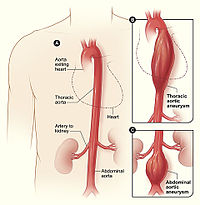
Photo from wikipedia
Re-operative aortic arch operations (REDO) following previous cardiac surgery are challenging procedures associated with significant morbidity and mortality. We investigated post-operative outcomes for patients undergoing REDO and identified risk-factors for… Click to show full abstract
Re-operative aortic arch operations (REDO) following previous cardiac surgery are challenging procedures associated with significant morbidity and mortality. We investigated post-operative outcomes for patients undergoing REDO and identified risk-factors for mortality in a contemporary series. From 1/2005-6/2018, 365 consecutive patients at an academic center underwent REDO: 257 HEMIARCH and 108 COMPLETE arch (45 stage I elephant trunk, 63 total arch) replacements. Outcomes included mortality and major adverse events. Long-term survival was determined with Kaplan-Meier analysis, and risk-factors for mortality were assessed with Cox proportional hazards regression. Operative mortality for the entire cohort was 6.8%, and rates of stroke, cardiac arrest, and renal failure were 6.0%,7.4%,and 10.4%. Compared to HEMIARCH, COMPLETE patients had an increased incidence of renal failure requiring dialysis (15.7% vs 8.2%, p=0.031) and re-exploration for bleeding or delayed chest closure (19.4% vs. 11.7%, p=0.051). Although operative mortality was similar in both cohorts, long-term follow-up mortality (38.0% vs 26.8%, p=0.047) was higher among COMPLETE vs. HEMIARCH. Predictors of overall mortality among all-comers undergoing REDO included older age, low body surface area, endocarditis, ejection fraction <30%, emergent status of operation, extended cardiopulmonary bypass duration, intra-aortic balloon pump use, and a more extensive arch operation. Previous aortic surgery was not a risk-factor for mortality. Among all-comers undergoing REDO, survival was 81.4% at 1 year, 66.7% at 5 years, and 56.4% at 10 years of follow-up. While early postoperative outcomes are similar among HEMIARCH and COMPLETE, a more extensive arch-replacement is an independent risk-factor for overall mortality in REDO. Using appropriate clinical indications in the current era, REDO remains a viable option for selected patients.
Journal Title: Seminars in thoracic and cardiovascular surgery
Year Published: 2021
Link to full text (if available)
Share on Social Media: Sign Up to like & get
recommendations!